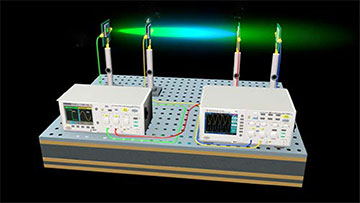
A group of researchers in China has shown how nested pairs of specially coated quantum well diodes allow the simultaneous transmission of two data streams along a single optical channel, with the outside pair green light and the inside blue. [Image: K. Fu et al. “Full-duplex visible light communication system using a single channel,” Opt. Lett. 47, 4802 (2022).]
Researchers in China have demonstrated a free-space optical communications channel capable of transmitting and receiving two sets of data at the same time (Opt. Lett., doi: 10.1364/OL.470796). They say that the new scheme, which relies on the emission and absorption properties of quantum well diodes, would halve both the space and cost of a duplex optical channel.
Blue and green diodes
A multiple quantum well III-nitride diode is a chip-based structure that simultaneously emits and absorbs light across a range of wavelengths, with portions of its emission and absorption spectra overlapping. This characteristic allows the diode to function as both a transmitter and a receiver, so just two such diodes are needed to set up a wireless communications link, since both are able to modulate a carrier wave to encode information optically and also detect modulated light to recover information from the other end.
In the latest work, a group led by Yongjin Wang of Nanjing University of Posts and Telecommunications used a multiple quantum well III-nitride diode measuring just 5.5 mm × 4.1 mm × 0.22mm. To the underside of the diode, the researchers added a Bragg reflection coating just 2.3-µm thick that contained 36 pairs of silicon-dioxide and titanium-dioxide film layers. This coating acted in effect as a filter, allowing the transmission or reflection of blue or green visible light to boost the capacity of an otherwise single communication channel.
The researchers fabricated two slightly different filters by varying the distribution of the silicon-dioxide and titanium-dioxide layers within the coating. The filter for the “blue” diodes had a sharp transition in its reflectivity spectrum at about 550 nm, so it intercepted blue light but remained largely transparent to longer-wavelength green light. The other filter, for the “green” diodes, instead had its transition at about 590 nm, thereby blocking the transmission of both wavelengths.
To make their duplex communication channel, Wang and colleagues arranged two blue diodes and two green diodes in a line—placing the former in between the latter. The idea was that the blue diodes could transmit and receive data interchangeably, while allowing green light to pass more or less undisturbed between the other pair of diodes placed outside.
Two simultaneous data streams
Analyzing the optical characteristics of their setup, the researchers found that both pairs of diodes were able to convert variations in electrical current to changes in light intensity and vice versa, thereby demonstrating the system’s ability to transfer information. They also confirmed that, in both cases, there were regions of the transmission and absorption spectra that overlapped, meaning that the communication channel can be made from pairs of identical diodes.
The researchers then showed that they could send two data streams at the same time. They varied the voltage of the blue transmitter to generate a random series of long and short light pulses at 100 binary bits per second (bps), which the blue receiver picked up and converted back into an electrical signal. They were able to do something similar at 10 bps with the green diode pair—although, in this case, the presence of the blue diodes along the line of sight meant they had to use what is known as envelope detection to improve the signal-to-noise ratio.
Reducing cost and space
The bottom line, write Wang and colleagues, is that they can send two sets of data simultaneously along the same channel, rather than having separate transmitters and receivers at each end. This implies that a single free-space link would be enough for duplex communication, which, they note, would halve both the cost and volume of employing such a double channel.
They reckon that this system could prove a boon to the Internet of Things, given that each diode combines a variety of light emission, detection and energy-harvesting functions. Alternatively, they write, it could serve as a backup for full-duplex communication.
The researchers acknowledge that a number of technical hurdles must be overcome before their scheme yields working products, including the need for smaller devices to increase the rate of data transmission—going from the current device size of thousands of square micrometers to just tens of square micrometers. However, they think that if they can perfect the technology, it might one day find use in photonic processors, given the simplicity and lower cost potentially offered by communication schemes featuring single rather than multiple optical paths.
